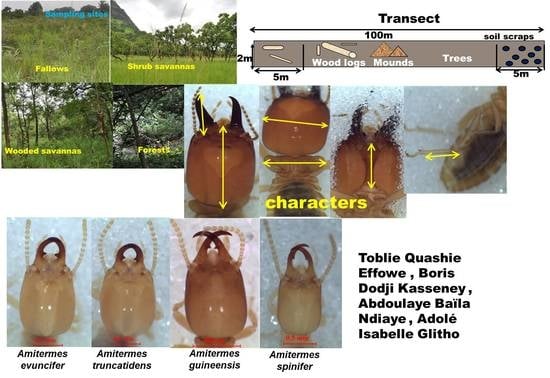Record of New Termite (Blattodea, Termitidae) Species in Togo West Africa †
Abstract
:Simple Summary
Abstract
1. Introduction
2. Materials and Methods
2.1. Study Areas
2.2. Termites Sampling
2.3. Termites Identification
2.4. Statistical Analysis
3. Results
3.1. Foraminitermes Species
3.2. Lepidotermes Species
3.3. Noditermes Species
3.4. Unguitermes Species
3.5. Amitermes Species
3.6. Promirotermes Species
4. Discussion
5. Conclusions
Author Contributions
Funding
Institutional Review Board Statement
Informed Consent Statement
Data Availability Statement
Acknowledgments
Conflicts of Interest
References
- Emerson, A.E. Geographical origins and dispersion of termite genera. Fieldiana. Zool. 1955, 37, 465–521. [Google Scholar] [CrossRef]
- Eggleton, P.E.; Williams, P.H.; Gaston, K.J. Explaining global termite diversity: Productivity or history? Biodivers. Conserv. 1994, 3, 318–330. [Google Scholar] [CrossRef]
- Eggleton, P. Global patterns of termite diversity. In Termites: Evolution, Sociality, Symbioses, Ecology; Abe, T., Bignell, D.E., Higashi, M., Eds.; Springer: Dordrecht, The Netherlands, 2000; pp. 941–960. [Google Scholar] [CrossRef]
- Dosso, K.; Konaté, S.; Aïdara, D.; Linsenmair, K.E. Termite diversity and abundance across fire-induced habitat variability in a tropical moist savanna (Lamto, central Côte d’Ivoire). J. Trop. Ecol. 2010, 26, 323–334. [Google Scholar] [CrossRef]
- Dosso, K.; Yéo, K.; Konaté, S.; Linsenmair, K.E. Importance of protected areas for biodiversity conservation in central Côte d’Ivoire: Comparison of termite assemblages between two neighbouring areas under differing levels of disturbance. J. Insect Sci. 2012, 12, 131. [Google Scholar] [CrossRef]
- Dosso, K.; Deligne, J.; Yéo, K.; Konaté, S.; Linsenmair, K.E. Changes in the termite assemblage across a sequence of land-use systems in the rural area around Lamto Reserve in Central Côte d’Ivoire. J. Insect Conserv. 2013, 17, 1047–1057. [Google Scholar] [CrossRef]
- Dosso, K.; Roisin, Y.; Tiho, S.; Konaté, S.; Yéo, K. Short-term changes in the structure of termite assemblages associated with slash-and-burn agriculture in Côte d’Ivoire. Biotropica 2017, 49, 856–861. [Google Scholar] [CrossRef]
- Grassé, P.P. Recherches sur la biologie des termites champignonnistes (Macrotermitinae). Ann. Sci. Nat. 1944, 6, 97–171. [Google Scholar]
- Bouillon, A.; Mathot, G. Quel est ce Termite Africain? Ed. de l’Université: Leopoldville, Belgian Congo, 1965; pp. 1–115. [Google Scholar]
- Josens, G. Etudes Biologique et Ecologique des Termites (Isoptera) de la Savane de Lamto-Pakobo (Côte d’Ivoire). Ph.D. Thesis, Université Libre de Bruxelles, Bruxelles, Belgique, 1972. [Google Scholar]
- Ruelle, J.E. Isoptera. In Biogeography and Ecology of Southern Africa. Monographiae Biologicae; Werger, M.J.A., Ed.; Springer: Dordrecht, The Netherlands, 1978; pp. 748–762. [Google Scholar] [CrossRef]
- Korb, J.; Kasseney, B.D.; Cakpo, Y.T.; Casalla Daza, R.H.; Gbenyedji, J.N.K.B.; Ilboudo, M.E.; Josens, G.; Koné, N.A.; Meusemann, K.; Ndiaye, A.B.; et al. Termite Taxonomy, challenges and prospects: West Africa, a case example. Insects 2019, 10, 32. [Google Scholar] [CrossRef] [PubMed]
- Silvestri, F. Termitidi raccolti da L. Fea alla Guinea Portoghese e alla Isole, S. Thomé, Annobon, Principe e Fernando Poo. Ann. Mus. Civ. Stor. Nat. 1912, 45, 211–255. [Google Scholar]
- Silvestri, F. Contribuzione alla conoscenza dei Termitidi e Termitophili dell’Africa occidentale. I. Termitidi. Bolletino Lab. Zool. Gen. Agrar. R Sc. Super. d’Agric. 1914, 9, 1–146. [Google Scholar]
- Emerson, A.E. Termites of the Belgian Congo and the Cameroon. Bull. Am. Mus. Nat. Hist. 1928, 57, 212–222. [Google Scholar]
- Grassé, P.P. Recherches sur la systématique et la biologie des termites de l’Afrique occidentale française. Première partie: Protermitidae, Mesotermitidae et Metatermitidae (Termitinae). Ann. Soc. Entomol. Fr. 1937, 106, 1–100. [Google Scholar]
- Roy-Noël, J. Le parc national du Niokolo-Koba. VIII. Isoptera. Mém. l’IFAN 1969, 84, 113–178. [Google Scholar]
- Sjöstedt, Y. Revision der Termiten Afrikas. 3. Monographie. In Kungl Svenska Vetenska Akademiens Handlingar; Almqvist & Wiksells Boktryckeri—A.-B.: Stockholm, Sweden, 1925; pp. 1–435. [Google Scholar]
- Sands, W.A. The termite genus Amitermes in Africa and the Middle East. Nat. Resour. Inst. Bull. 1992, 51, 1–140. [Google Scholar]
- Sands, W.A. The Identification of Worker Castes of Termite Genera from Soils of Africa and the Middle East; CAB International: Wallingford, UK, 1998; p. 512. [Google Scholar]
- Hellemans, S.; Deligne, J.; Roisin, Y.; Josens, G. Phylogeny and revision of the “Cubitermes complex” termites (Termitidae: Cubitermitinae). Syst. Entomol. 2021, 46, 224–238. [Google Scholar] [CrossRef]
- Ndiaye, A.B.; Njie, E.; Correa, P.A. Termites (Blattodea Latreille 1810, Termitoidae Latreille 1802) of Abuko Nature Reserve, Nyambai Forest Park and Tanji Bird Reserve (The Gambia). Insects 2019, 10, 122. [Google Scholar] [CrossRef]
- Ndiaye, A.B.; Ilboudo, M.E.; Sankara, F.; Bozdoğan, H. Diversity of Termites (Termitoidae Latreille) of the West Burkina Faso. Curr. Trends Entomol. Zool. Stud. 2021, 4, 113. [Google Scholar] [CrossRef]
- Jones, D.T.; Eggleton, P. Sampling termite assemblages in tropical forests: Testing a rapid biodiversity assessment protocol. J. Appl. Ecol. 2000, 37, 191–203. [Google Scholar] [CrossRef]
- Hausberger, B.; Kimpel, D.; van Neer, A.; Korb, J. Uncovering cryptic species diversity of a community in a West African Savanna. Mol. Phylogenet. Evol. 2011, 61, 964–969. [Google Scholar] [CrossRef]
- Schyra, J.; Korb, J. Termite Communities along a Disturbance Gradient in a West African Savanna. Insects 2019, 10, 17. [Google Scholar] [CrossRef]
- Effowe, T.Q.; Kasseney, B.D.; Ndiaye, A.B.; Sanbena, B.B.; Amevoin, K.; Glitho, I.A. Termites’ diversity in a protected park of the northern Sudanian savanna of Togo (West Africa). Nat. Conserv. 2021, 43, 79–91. [Google Scholar] [CrossRef]
- Engel, M.S.; Krishna, K. Family-Group Names for Termites (Isoptera); American Museum of Natural History: New York, NY, USA, 2004; pp. 1–9. [Google Scholar] [CrossRef]
- Constantino, R. Termite Database. Available online: http://termitologia.net (accessed on 2 May 2022).
- Krishna, K. The African Genus Foraminitermes Holmgren (Isoptera, Termitidae, Termitinae); American Museum of Natural History: New York, NY, USA, 1963; pp. 1–23. [Google Scholar]
- Ferrar, P. Termites of a South African Savanna. I. List of Species and Sub-habitat Preferences. Oecologia 1982, 52, 125–132. [Google Scholar] [CrossRef] [PubMed]
- Darlington, J.P.E.C. Termites (Isoptera) as secondary occupants in mounds of Macrotermes michaelseni (Sjöstedt) in Kenya. Insectes Soc. 2011, 59, 159–165. [Google Scholar] [CrossRef]
- Muvengwi, J.; Mbiba, M.; Ndagurwa, H.G.T.; Nyamadzawo, G.; Nhokovedzo, P. Termite diversity along a land use intensification gradient in a semi-arid savanna. J. Insect Conserv. 2017, 21, 801–812. [Google Scholar] [CrossRef]
- Netshifhefhe, S.R.; Kunjeku, E.C.; Visser, D.; Madzivhe, F.M.; Duncan, F.D. An Evaluation of Three Field Sampling Methods to Determine Termite Diversity in Cattle Grazing Lands. Afr. Entomol. 2018, 26, 224–233. [Google Scholar] [CrossRef]
- Williams, R.M.C. New East African Termitinae (Isoptera: Termitidae). Proc. R. Entomol. Soc. 1954, 23, 215–227. [Google Scholar] [CrossRef]
- Wasmann, E. Zur Kenntnis der Termiten und Termitengäste von Belgischen Kongo. Rev. Zool. Afr. 1911, 1, 91–117. [Google Scholar]
- Ruelle, J.E. Four new species of Ungitermes sjöstedt from Ethiopian region (Isoptera, Termitidae). C. Ser. A 1973, 2, 103–112. [Google Scholar]



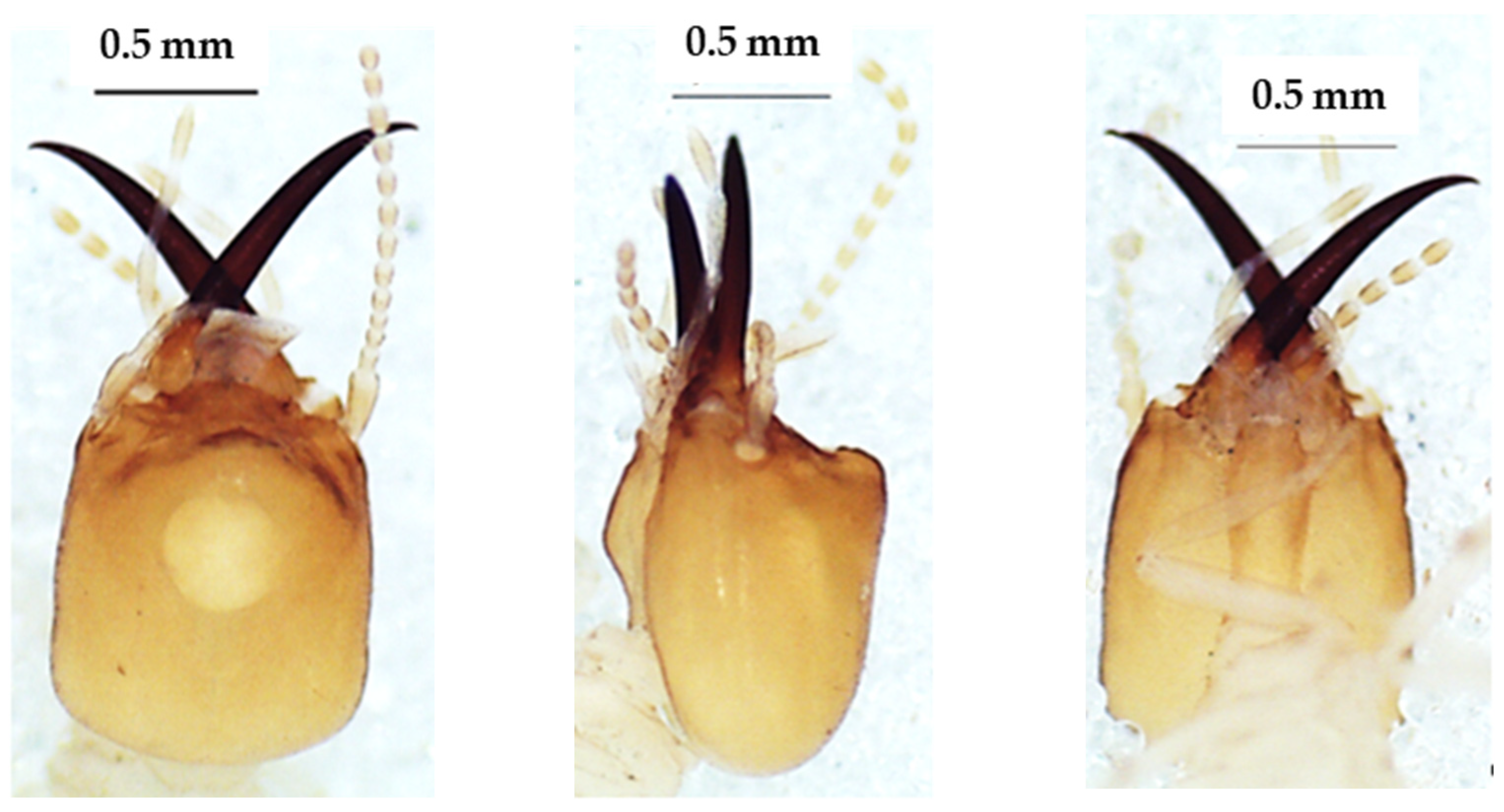


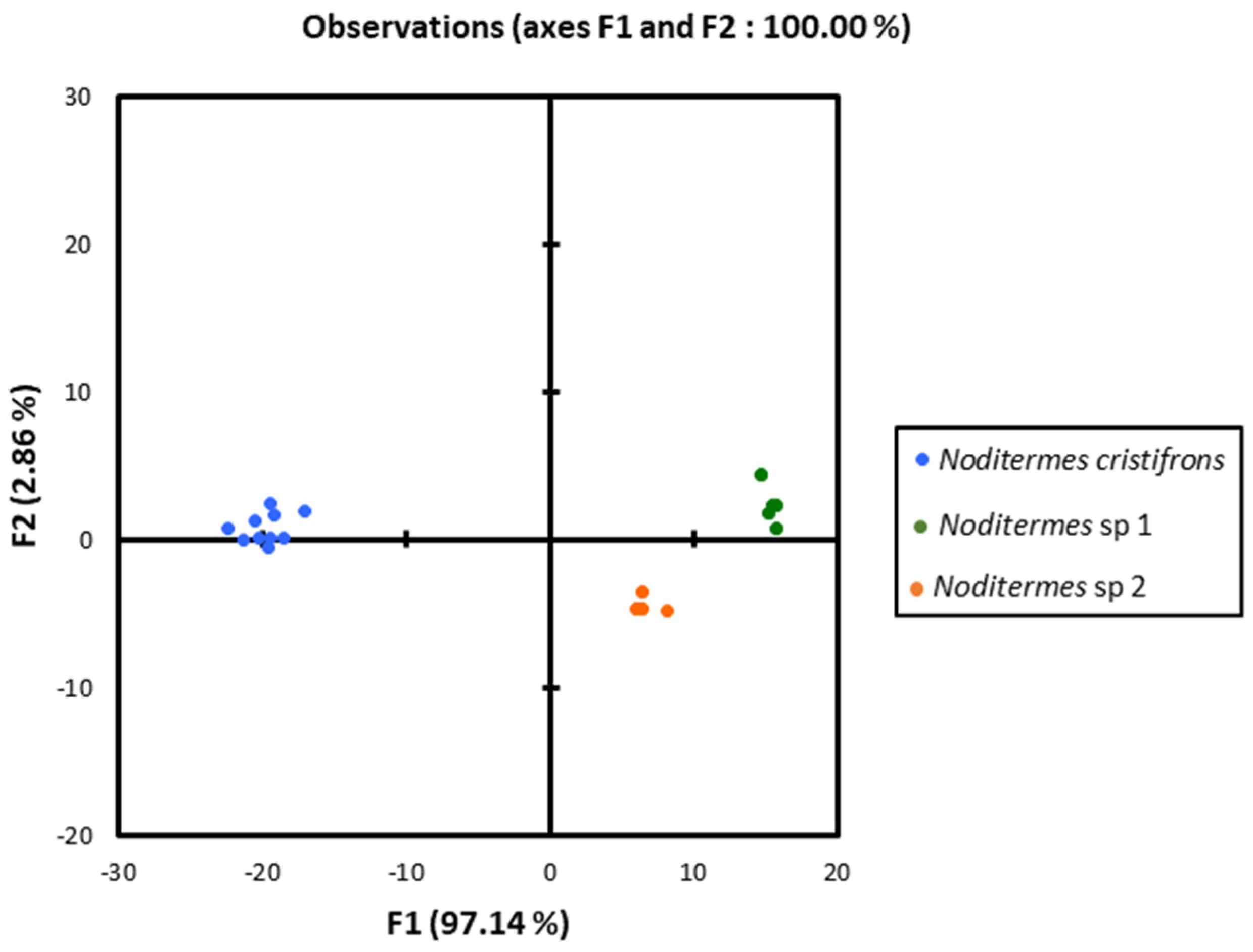
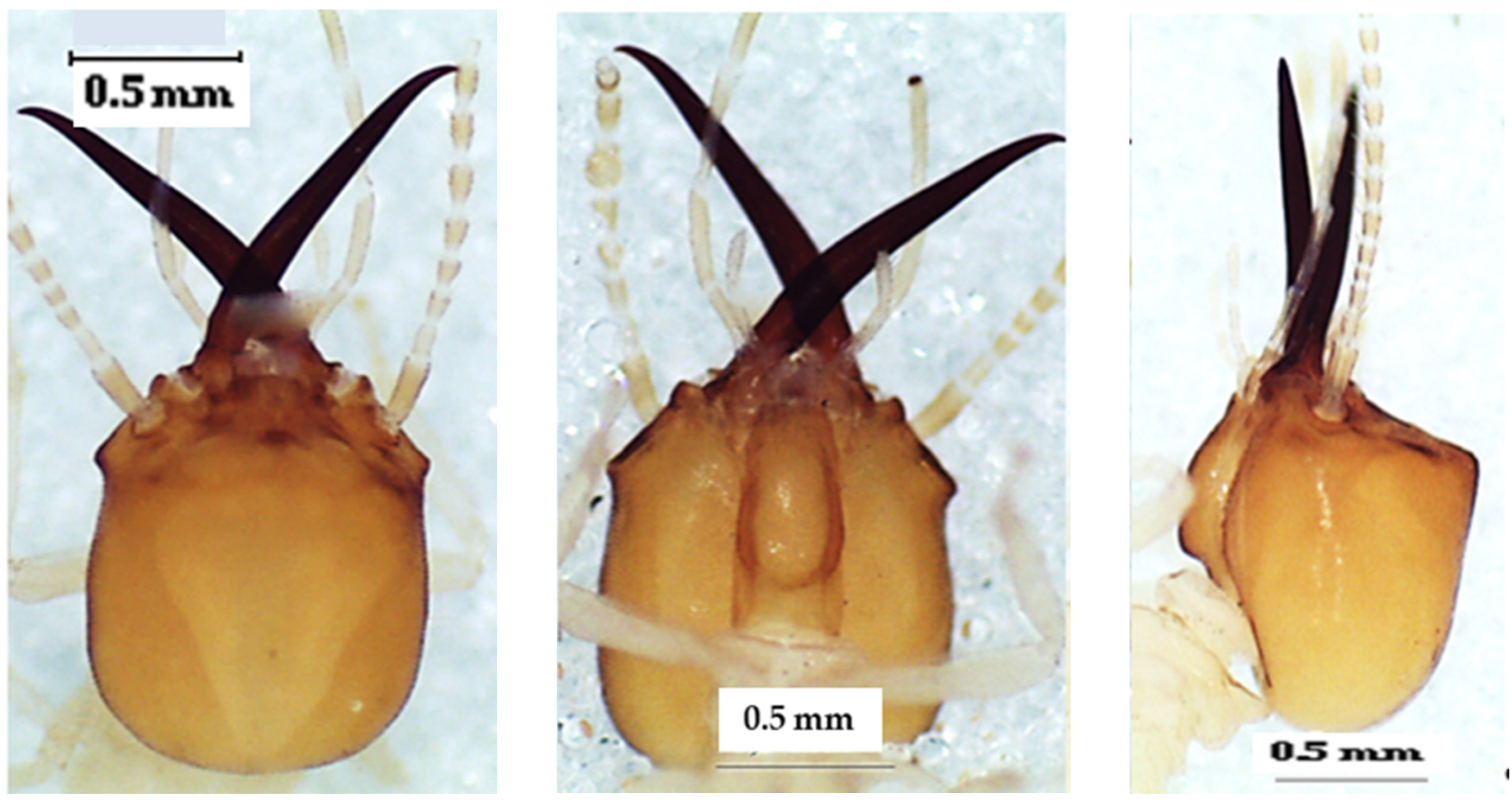
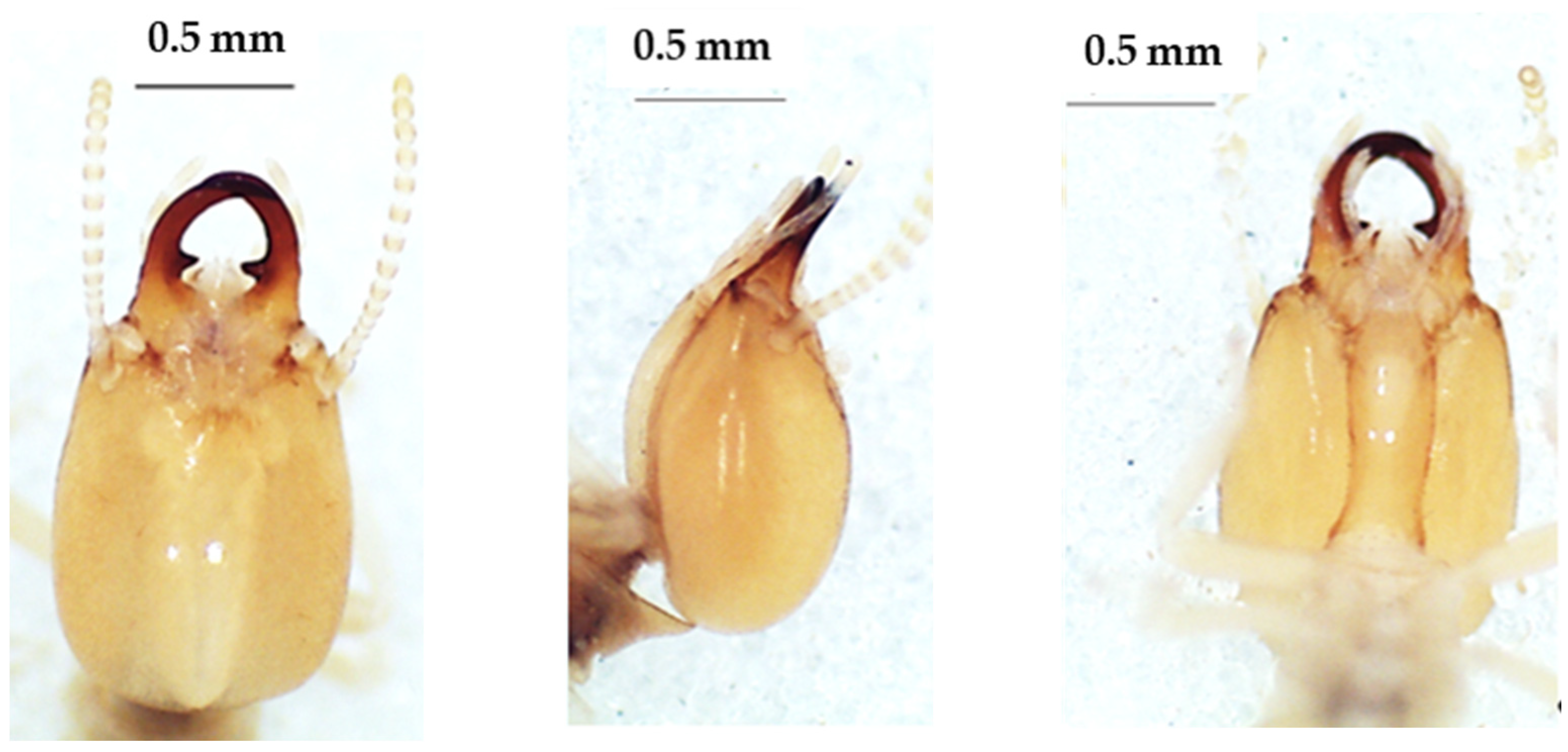





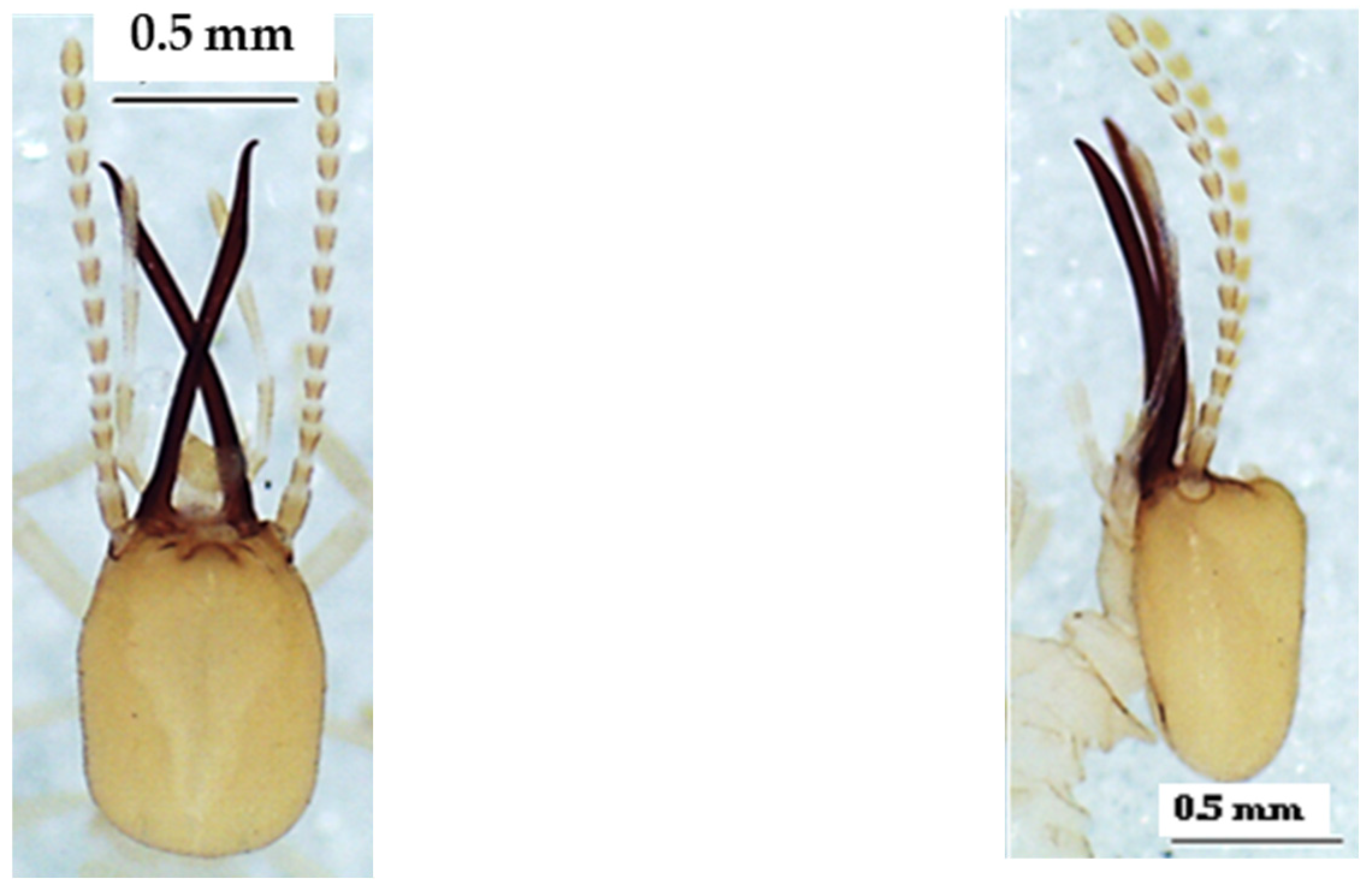
| Subfamily | Species | Distribution |
|---|---|---|
| Foraminitermitinae Holmgren, 1912 | Foraminitermes corniferus (Sjöstedt, 1905) | Fazao-Malfakassa |
| Lepidotermes sp. | Fazao-Malfakassa | |
| Noditermes cristifrons (Wasmann, 1911) | Fazao-Malfakassa, Galangashi | |
| Cubitermitinae Weidner, 1956 | Noditermes sp. 1 | Fazao-Malfakassa, Galangashi |
| Noditermes sp. 2 | Fazao-Malfakassa, Galangashi | |
| Unguitermes sp. | Fazao-Malfakassa | |
| Amitermes evuncifer (Silvestri,1912) | Fazao-Malfakassa, Galangashi, Fosse aux lions | |
| Amitermes guinensis (Sands, 1992) | Fazao-Malfakassa, Galangashi, Fosse aux lions | |
| Termitinae Latreille, 1802 | Amitermes spinifer (Silvestri, 1914) | Galangashi, Fosse aux lions |
| Amitermes truncatidens (Sands, 1959) | Fazao-Malfakassa, Galangashi, Fosse aux lions | |
| Promirotermes holmgreni infera Silvestri, 1914 | Fazao-Malfakassa | |
| Promirotermes sp. | Fazao-Malfakassa |
| Measured Characters | Measurements (mm) |
|---|---|
| Head length | 1.28 |
| Head width | 0.853 |
| Left mandible length | 0.555 |
| Pronotum width | 0.562 |
| Gula width | 0.817 |
| Hind tibia length | 0.7 |
| Measured Characters | Measurements (mm) |
|---|---|
| Head length | 1.14 |
| Head width | 1.05 |
| Left mandible length | 1.29 |
| Pronotum width | 0.482 |
| Gula width | 0.638 |
| Hind tibia length | 0.741 |
| Measured Characters | Range (mm) | Mean ± SD |
|---|---|---|
| Head length | 1.22–1.34 | 1.268 ± 0.038 |
| Head width | 0.91–1.09 | 1.002 ± 0.059 |
| Left mandible length | 1.17–1.38 | 1.237 ± 0.082 |
| Pronotum width | 0.5–0.516 | 0.508 ± 0.008 |
| Gula width | 0.239–0.31 | 0.279 ± 0.025 |
| Hind tibia length | 0.754–0.878 | 0.791 ± 0.044 |
| Measured Characters | Range (mm) | Mean ± SD |
|---|---|---|
| Head length | 1.6–1.67 | 1.626 ± 0.027 |
| Head width | 1.07–1.19 | 1.15 ± 0.046 |
| Left mandible length | 1.31–1.38 | 1.35 ± 0.026 |
| Pronotum width | 0.609–0.62 | 0.616 ± 0.004 |
| Gula width | 0.263–0.301 | 0.284 ± 0.015 |
| Hind tibia length | 0.734–0.936 | 0.886 ± 0.086 |
| Measured Characters | Range (mm) | Mean ± SD |
|---|---|---|
| Head length | 1.36–1.39 | 1.372 ± 0.012 |
| Head width | 1.09–1.12 | 1.105 ± 0.013 |
| Left mandible length | 1.26–1.33 | 1.285 ± 0.031 |
| Pronotum width | 0.563–0.597 | 0.579 ± 0.013 |
| Gula width | 0.265–0.288 | 0.275 ± 0.006 |
| Hind tibia length | 0.808–0.832 | 0.814 ± 0.012 |
| Measured Characters | Range (mm) | Mean ± SD |
|---|---|---|
| Head length | 1.16–1.2 | 1.18 ± 0.028 |
| Head width | 0.986–1.02 | 1.003 ± 0.024 |
| Left mandible length | 1.21–1.28 | 1.245 ± 0.045 |
| Pronotum width | 0.54–0.6 | 0.57 ± 0.04 |
| Gula width | 0.301–0.32 | 0.31 ± 0.013 |
| Hind tibia length | 0.772–0.793 | 0.782 ± 0.014 |
| Measured Characters | Range (mm) | Mean ± SD |
|---|---|---|
| Head length | 1.06–1.19 | 1.134 ± 0.049 |
| Head width | 0.93–0.975 | 0.954 ± 0.014 |
| Left mandible length | 0.594–0.709 | 0.660 ± 0.038 |
| Pronotum width | 0.587–0.615 | 0.600 ± 0.011 |
| Gula width | 0.252–0.3 | 0.279 ± 0.016 |
| Hind tibia length | 0.828–1.2 | 0.970 ± 0.126 |
| Measured Characters | Range (mm) | Mean ± SD |
|---|---|---|
| Head length | 1.17–1.27 | 1.225 ± 0.031 |
| Head width | 0.677–0.979 | 0.871 ± 0.008 |
| Left mandible length | 0.611–0.795 | 0.722 ± 0.058 |
| Pronotum width | 0.139–0.287 | 0.438 ± 0.013 |
| Gula width | 0.139–0.287 | 0.213 ± 0.041 |
| Hind tibia length | 0.503–0.519 | 0.509 ± 0.005 |
| Measured Characters | Range (mm) | Mean ± SD |
|---|---|---|
| Head length | 0.865–0.954 | 0.933 ± 0.018 |
| Head width | 0.681–0.742 | 0.726 ± 0.027 |
| Left mandible length | 0.585–0.624 | 0.613 ± 0.017 |
| Pronotum width | 0.472–0.492 | 0.486 ± 0.009 |
| Gula width | 0.257–0.26 | 0.288 ± 0.020 |
| Hind tibia length | 0.642–0.65 | 0.643 ± 0.017 |
| Measured Characters | Range (mm) | Mean ± SD |
|---|---|---|
| Head length | 1.01–1.13 | 1.064 ± 0.037 |
| Head width | 0.943–0.992 | 0.966 ± 0.016 |
| Left mandible length | 0.522–0.577 | 0.547 ± 0.023 |
| Pronotum width | 0.564–0.576 | 0.575 ± 0.007 |
| Gula width | 0.27–0.314 | 0.284 ± 0.021 |
| Hind tibia length | 0.756–0.816 | 0.785 ± 0.025 |
| Measured Characters | Range (mm) | Mean ± SD |
|---|---|---|
| Head length | 1.27–1.31 | 1.29 ± 0.014 |
| Head width | 0.994–1.08 | 1.040 ± 0.034 |
| Left mandible length | 1.57–1.74 | 1.674 ± 0.063 |
| Pronotum width | 0.787–0.826 | 0.802 ± 0.02 |
| Gula width | 0.27–0.36 | 0.31 ± 0.037 |
| Hind tibia length | 1.1–1.23 | 1.136 ± 0.05 |
| Measured Characters | Range (mm) | Mean ± SD |
|---|---|---|
| Head length | 0.877–0.879 | 0.878 ± 0.014 |
| Head width | 0.692–0.995 | 0.693 ± 0.021 |
| Left mandible length | 1.11–1.13 | 1.12 ± 0.015 |
| Pronotum width | 0.75–0.77 | 0.76 ± 0.014 |
| Gula width | 0.33–0.344 | 0.337 ± 0.009 |
| Hind tibia length | 0.667–0.67 | 0.668 ± 0.0016 |
Publisher’s Note: MDPI stays neutral with regard to jurisdictional claims in published maps and institutional affiliations. |
© 2022 by the authors. Licensee MDPI, Basel, Switzerland. This article is an open access article distributed under the terms and conditions of the Creative Commons Attribution (CC BY) license (https://creativecommons.org/licenses/by/4.0/).
Share and Cite
Effowe, T.Q.; Kasseney, B.D.; Ndiaye, A.B.; Glitho, A.I. Record of New Termite (Blattodea, Termitidae) Species in Togo West Africa. Insects 2022, 13, 841. https://doi.org/10.3390/insects13090841
Effowe TQ, Kasseney BD, Ndiaye AB, Glitho AI. Record of New Termite (Blattodea, Termitidae) Species in Togo West Africa. Insects. 2022; 13(9):841. https://doi.org/10.3390/insects13090841
Chicago/Turabian StyleEffowe, Toblie Quashie, Boris Dodji Kasseney, Abdoulaye Baïla Ndiaye, and Adolé Isabelle Glitho. 2022. "Record of New Termite (Blattodea, Termitidae) Species in Togo West Africa" Insects 13, no. 9: 841. https://doi.org/10.3390/insects13090841
APA StyleEffowe, T. Q., Kasseney, B. D., Ndiaye, A. B., & Glitho, A. I. (2022). Record of New Termite (Blattodea, Termitidae) Species in Togo West Africa. Insects, 13(9), 841. https://doi.org/10.3390/insects13090841





